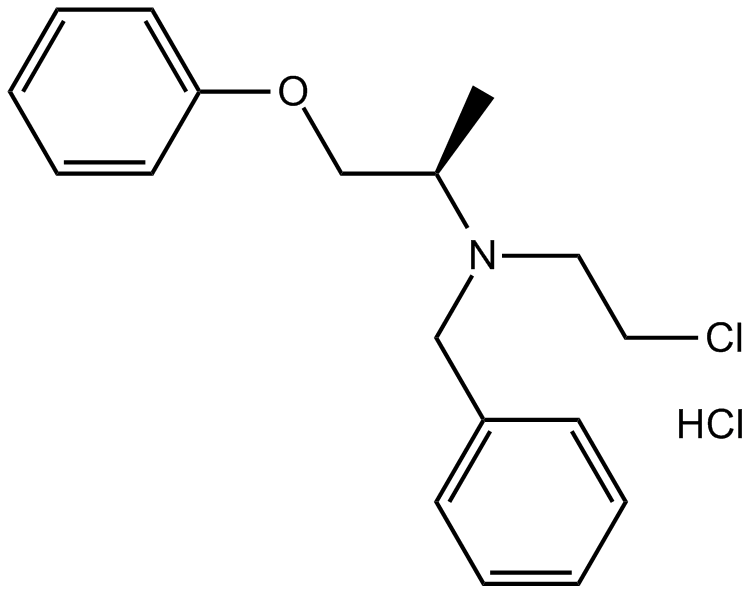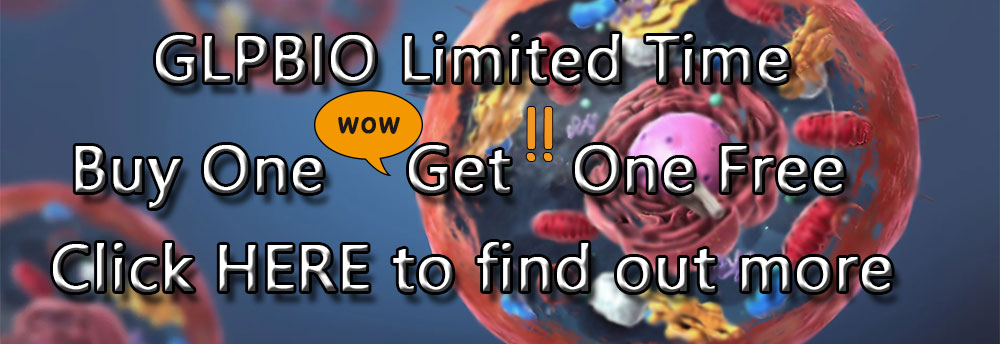Phenoxybenzamine HCl (Synonyms: NSC 37448) |
| Catalog No.GC12724 |
Le chlorhydrate de phénoxybenzamine est un antagoniste des récepteurs adrénergiques non sélectif, irréversible, actif par voie orale, couramment utilisé pour la recherche de l'hypertension, spécifiquement causée par un phéochromocytome.
Products are for research use only. Not for human use. We do not sell to patients.

Cas No.: 63-92-3
Sample solution is provided at 25 µL, 10mM.
Phenoxybenzamine hydrochloride is a selective antagonist of both α-adrenoceptor and calmodulin that is commonly used for the treatment of hypertension, specifically caused by pheochromocytoma.
The IC50 (100 nM) derived from the blockade of [3H]yohimbine binding by Phenoxybenzamine hydrochloride is significantly less than the IC50 (550 nM) for the corresponding reversal by Phenoxybenzamine hydrochloride of the effects of norepinephrine on cyclic AMP accumulation[1]. Phenoxybenzamine hydrochloride (50 nM) in conbination with Phenoxybenzamine hydrochloridetolamine (1000 nM) enhances Phenoxybenzamine hydrochlorideylephrine-induced contraction compared with pretreatment with Phenoxybenzamine hydrochloride (50 nM) alone in endothelium-intact aortae. Combined treatment with either dexmedetomidine (300 or 1000 nM) and Phenoxybenzamine hydrochloride (50 nM) or Phenoxybenzamine hydrochloridetolamine (1000 nM) and Phenoxybenzamine hydrochloride (50 nM) enhance Phenoxybenzamine hydrochlorideylephrine-induced contraction compared with Phenoxybenzamine hydrochloride alone (50 nM). In addition, combined treatment with Phenoxybenzamine hydrochloridetolamine and Phenoxybenzamine hydrochloride enhances Phenoxybenzamine hydrochlorideylephrine-induced contraction compared with dexmedetomidine (1000 nM) and Phenoxybenzamine hydrochloride combined treatment. Combined treatment with high concentrations of dexmedetomidine (1000 nM) and Phenoxybenzamine hydrochloride enhances Phenoxybenzamine hydrochlorideylephrine-induced contraction compared with combined treatment with low concentrations of dexmedetomidine (300 nM) and Phenoxybenzamine hydrochloride[2]. Phenoxybenzamine hydrochloride (0.1-100 μM) inhibits glioma proliferation, migration, and invasion and suppresses the tumorigenesis capacity. Phenoxybenzamine hydrochloride also inhibits self-renewal of glioma stem-like cells. Phenoxybenzamine hydrochloride activates LINGO-1 and inhibits the TrkB-Akt pathway[3]. Phenoxybenzamine hydrochloride (0.1 μM-1 mM) preserves primary neurons within the CA1, CA3 and dentate gyrus and produces a robust neuroprotective effect, and prevents neuronal death from OGD in all regions of the hippocampus when delivered at 2, 4, and 8 h post-OGD at 100 μM[4].
Phenoxybenzamine hydrochloride (20 nM, s.c.) effectively suppresses the tumorigenesis of glioma cells in mice and the cell density in Phenoxybenzamine hydrochloride-U87MG xenografts decreases significantly[3]. Phenoxybenzamine hydrochloride (1 mg/kg, i.v.) treated rats shows significant improvements in NSS and foot fault scoring[4].
Reference:
[1]. Lenox, R.H., et al, Alpha 2-adrenergic receptor-mediated regulation of adenylate cyclase in the intact human platelet. Evidence for a receptor reserve. Mol Pharmacol, 1985. 27(1): p. 1-9.
[2]. Byon HJ, et al. Dexmedetomidine Inhibits Phenylephrine-induced Contractions via Alpha-1 Adrenoceptor Blockade and Nitric Oxide Release in Isolated Rat Aortae. Int J Med Sci. 2017 Feb 7;14(2):143-149.
[3]. Lin XB, et al. Anti-tumor activity of phenoxybenzamine hydrochloride on malignant glioma cells. Tumour Biol. 2016 Mar;37(3):2901-8.
[4]. Rau TF, et al. Phenoxybenzamine is neuroprotective in a rat model of severe traumatic brain injury. Int J Mol Sci. 2014 Jan 20;15(1):1402-17.
Average Rating: 5 (Based on Reviews and 28 reference(s) in Google Scholar.)
GLPBIO products are for RESEARCH USE ONLY. Please make sure your review or question is research based.
Required fields are marked with *




















